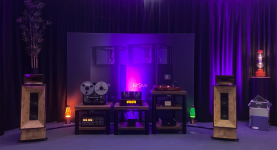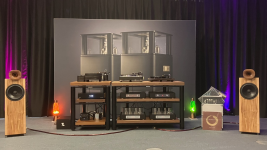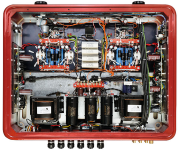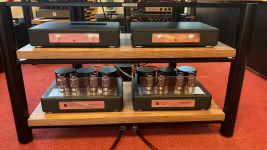Agreed. Models and theories are useful, especially for engineering.
But hardly any of the founders of quantum physics would fully agree with such a rigid definition.
It's part of the reason why there has been no major breakthrough in the past 100 years.
Instead, we have a bunch of theories.
But hardly any of the founders of quantum physics would fully agree with such a rigid definition.
It's part of the reason why there has been no major breakthrough in the past 100 years.
Instead, we have a bunch of theories.
I am shure there were major breakthroughs, but some tiny segment of our population are keeping them away from the people for many years now. Exemple: Nikola Tesla his inventions. A bunch of theories is what we are allowed to know and work with. But I understand that this is off-topic 😆
In that context it is a subjective term. A scientist prefers to use the term in the sense of something measurable (coherence can be measured) because then it can be used to scale a system along that axis allowing for comparisons between systems on a level playing field, unlike when using the term subjectively.I used 'coherent' in a different context, not to dismiss yours > 'forming a unified whole'.
Where have you been? My physics was rocked to its core in the last 100 years!!It's part of the reason why there has been no major breakthrough in the past 100 years.
Instead, we have a bunch of theories.
Off topic and out of this world!But I understand that this is off-topic 😆
Flat response speakers have rarely been used in music production environments throughout history. From a scientific perspective, playing back such material on a flat response speaker is not necessarily the best choice. It’s the same as viewing an image edited on a computer monitor with incorrect color calibration on a properly calibrated display. The colors will be off.That is why people enjoy their favorite song on a clock radio in the morning as much as on a high end set 😉
In the end, both a clock radio and the highest performing flat response speaker simply have frequency characteristics that are skewed in just different ways.
In that context it is a subjective term. A scientist prefers to use the term in the sense of something measurable (coherence can be measured) because then it can be used to scale a system along that axis allowing for comparisons between systems on a level playing field, unlike when using the term subjectively.
That's why I made a distinction between your post and my subjective opinion.
However, your example seems to me to be more related to applied science/engineering, based on classical physics, the branch of physics that primarily deals with macroscopic (known) phenomena.
The current debate in scientific circles is rife with questions about the nature of science itself.
My comments on this are merely a reflection of these developments, which I personally welcome and which fit into this turbulent era.
Last edited:
Coherence (my definition) plays a very strong role in quantum mechanics - not macroscopic.However, your example seems to me to be more related to applied science/engineering, based on classical physics, the branch of physics that primarily deals with macroscopic (known) phenomena.
Coherence (my definition) plays a very strong role in quantum mechanics - not macroscopic.
As does decoherence (the process by which a quantum system loses its “coherence” - its capacity to exist in multiple states simultaneously - due to interaction with the environment > the appearance of wave function collapse).
In another thread I referred to the (related) recent work of Federico Faggin - the Venetian physicist who designed the world's first microprocessor, which essentially revives the Monadology of the (underappreciated) 17th century genius Gottfried Wilhelm Leibniz.
Last edited:
You guys have discussed the limitations in the past, I believe what I am speaking on involves getting ER level low enough for clarity, and then having a uniform spectral Decay, but not so much expectation of a short decay? Maybe I can find the comments. There is another aspect, to this, maybe you can put it all into context. Decay times versus Frequency. I do recall you saying that you see an uniform decay time across the spectrum as ideal? Which is sort of counterintuitive given cycle times and the contrast hadI like a lively room, but imaging is paramount to me and that is my central goal. I'd give up some spaciousness for improved imaging.
I used 20db as a threshold for hearing. I don't know if that gets me anywhere since the whole is much more complicated and I trying to generalize. Then theres masking. Either way, thats what I was getting at.... The lower the indirect sound SPL is initially, the sooner it can reached a low enough to either be masked or reach the threshold of hearing. Without trying use a SPL level for designation the idea seems to float much better lol.This is meaningless unless you put the SPL number in some context - i.e. relative to what?
True for the non-modal region, but in a small room there should be more absorption and hence a faster decay. A uniform decay with frequency in the non-modal region is going to be the norm since most absorption is broadband even if not exactly flat.Decay times versus Frequency. I do recall you saying that you see an uniform decay time across the spectrum as ideal? Which is sort of counterintuitive given cycle times and the contrast had
It is generally held that reverberation is inaudible/insignificant once it falls by 15-20 dB. There is no need for it to fall below our threshold of hearing.I used 20db as a threshold for hearing. I don't know if that gets me anywhere since the whole is much more complicated and I trying to generalize. Then theres masking. Either way, thats what I was getting at.... The lower the indirect sound SPL is initially, the sooner it can reached a low enough to either be masked or reach the threshold of hearing. Without trying use a SPL level for designation the idea seems to float much better lol.
The part that you may be missing is that there is a delay of reverberation behind the direct sound followed by a rise and then a fall in level. There is more to consider than just the decay.
The delay of reverberation also affects the perceived spaciousness/depth of soundfield.
The shorter the delay (< 20ms), the more intimate the experience (> 'they' are here). Apparently the position of the speakers is also a factor.
To take this one step further: the 'acoustic disappearance act' also depends on the position of the speakers, as well as the size, shape and directivity characteristics.
Most of my friends prefer a spatial experience, except those who produce music.
The shorter the delay (< 20ms), the more intimate the experience (> 'they' are here). Apparently the position of the speakers is also a factor.
To take this one step further: the 'acoustic disappearance act' also depends on the position of the speakers, as well as the size, shape and directivity characteristics.
Most of my friends prefer a spatial experience, except those who produce music.
As mentioned earlier in this thread: the only system I've listened to that could clearly pull off both illusionary tricks (they are here & you are there) - by a wide margin, was the one below.
Before I heard the system I had a conversation with an elderly German with decades of experience with horn speakers.
He specifically suggested to listen to this system, which (also) according to him was a standout at the show.
It literally reduced all cherished (cardiod) directivity champions to mere toys (grandma's kitchen radios).
An all-analog tube setup without tricks, except a large curtained room.
Yes, it's just an opinion, but this system made it to most best-of-show lists for a reason.
It still wasn't perfect. There was noticeable pattern flip (on vertical movement) and the integration between the waveformer and the small radial horn wasn't seamless.

The contrast with the system in the same room that was used the following year could hardly have been greater.
Bloated bass with overhang, virtually non-existent integration (coherence) between the direct radiator and the (undersized) freestanding waveguide.
The tonal signature was still okay, but you had to pay specific attention > listen through all the distracting clutter.

Before I heard the system I had a conversation with an elderly German with decades of experience with horn speakers.
He specifically suggested to listen to this system, which (also) according to him was a standout at the show.
It literally reduced all cherished (cardiod) directivity champions to mere toys (grandma's kitchen radios).
An all-analog tube setup without tricks, except a large curtained room.
Yes, it's just an opinion, but this system made it to most best-of-show lists for a reason.
It still wasn't perfect. There was noticeable pattern flip (on vertical movement) and the integration between the waveformer and the small radial horn wasn't seamless.

The contrast with the system in the same room that was used the following year could hardly have been greater.
Bloated bass with overhang, virtually non-existent integration (coherence) between the direct radiator and the (undersized) freestanding waveguide.
The tonal signature was still okay, but you had to pay specific attention > listen through all the distracting clutter.

Last edited:
Hmm, I see two completely different systems, in many aspects. You can compare of course, but isn't it imposssible to pinpoint the source of the hugely different performance to only the speakers? EDIT: Ro808 speaks about systems, so not in particular about the speakers -although he makes some references to them.
Last edited:
Good point.
The differences I have experienced are well known and have been observed by others. AO during a private listening session for journalists, where 3 different systems of the same brand were compared; exactly the 2 mentioned above + the much larger top model, which costs a multiple of the first system from my previous post.
In a deleted post AllenB referred to the usefulness of studying scientific literature. I fully endorse that statement.
Last year around this time I spent 3 months studying all the scientific literature I could find regarding Class D amplification.
Although I have several class D amps myself and I admire the contributions of Bruno Putzeys, my conclusion was that Class D doesn't meet the most stringent requirements for signal integrity.
I am going through a similar process regarding DA conversion.
The differences I have experienced are well known and have been observed by others. AO during a private listening session for journalists, where 3 different systems of the same brand were compared; exactly the 2 mentioned above + the much larger top model, which costs a multiple of the first system from my previous post.
In a deleted post AllenB referred to the usefulness of studying scientific literature. I fully endorse that statement.
Last year around this time I spent 3 months studying all the scientific literature I could find regarding Class D amplification.
Although I have several class D amps myself and I admire the contributions of Bruno Putzeys, my conclusion was that Class D doesn't meet the most stringent requirements for signal integrity.
I am going through a similar process regarding DA conversion.
Hmm, I see two completely different systems, in many aspects. You can compare of course, but isn't it imposssible to pinpoint the source of the hugely different performance to only the speakers? EDIT: Ro808 speaks about systems, so not in particular about the speakers -although he makes some references to them.
The biggest difference was the amplification.
The first setup featured a 300B PSE integrated amplifier (2 x 20 Watts):

While the second system was powered by a, slightly cheaper, 4 x 60 Watts (KT88) horizontal bi-amp confifuration, exactly this one:

Last edited:
You could have asked 😉In a deleted post AllenB referred to the usefulness of studying scientific literature.
I will show the comment you are referring to from the other day..
I would seek a balance, as I think the scientific explanation that Earl has given also adds nuance and gives clues. Reading studies gives insight.My personal objections to the scientism (~reductionist) approach is that it's usually not refined enough with respect to the basics. In other words, it ignores the subtle aspects > sub(-sub-sub) domain interdependence, (integrity of the) signal path etc.
- Home
- Loudspeakers
- Multi-Way
- Is it possible to cover the whole spectrum, high SPL, low distortion with a 2-way?